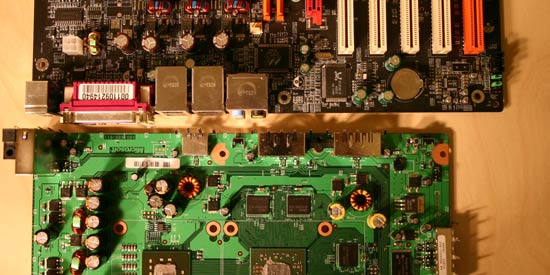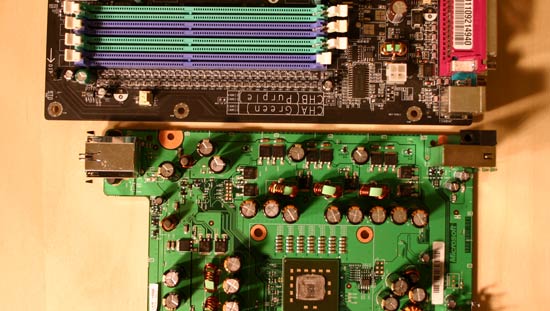Inside Microsoft's Xbox 360 - A Tour of the 360's Motherboard
by Anand Lal Shimpi on November 18, 2005 12:19 AM EST- Posted in
- Systems
On Wednesday we took apart the Xbox 360 to satisfy our curiosities and provide a tutorial to all those willing to take time out of gaming in order to take theirs apart as well. Today, we take a bit of a different approach, focusing on one item within the sleekly design chassis in particular - the Xbox 360 motherboard.
We've been reviewing motherboards on AnandTech for over eight years now, so of course taking look at the Xbox 360's motherboard in greater detail is right up our alley. Before proceeding, we recommend taking a look at our Inside the Xbox 360 article, which diagrams taking it apart as well as provides a brief overview of the technology in the system.
The original Xbox featured a 4-layer Intel motherboard, but given the incredible power requirements of the CPU and GPU on the Xbox 360's motherboard we would be astonished if the same were true today. Luckily with any console, especially early on in their life, you are getting a true bargain when it comes to the cost of hardware - so the number of layers on this PCB doesn't matter much to the end user, as Microsoft will absorb all costs above and beyond the core system's $299 price tag.
We've already shown a picture of the motherboard, but here's another shot as a refresher:

To help you orient yourself, the bottom of the picture is the front of the unit and the left of the picture is where you would see the optional hard drive. Keep this picture in mind as we go through the tour of the motherboard, as you'll see a thumbnail of this board in almost every picture in the coming pages, with the component we're discussing at the time circled in red.
The motherboard is quite small in order to give the Xbox 360 a much more slender look compared to its predecessor, which basically used a regular sized ATX motherboard. Below we have a picture of it lined up next to a standard ATX motherboard - in this case a MSI K8N Neo2:


With the size put in perspective, let's begin the tour.










27 Comments
View All Comments
Calin - Friday, November 18, 2005 - link
Power can be provided using two complete layers- one for ground, one for power. With the added benefit that, if they separate layers with data connections (those nice lines), they reduce interference between signals on different layers.Lifted - Friday, November 18, 2005 - link
Loading a little faster this time around. Ohh look, pictures!Gigahertz19 - Friday, November 18, 2005 - link
Haha 1st post..who carez about X-Box..I got my PCDonegrim - Friday, November 18, 2005 - link
A pc with a similar spec to the xbox would cost at least 3 times as much, probably more. And to play multiplayer games you would need another pc per person.DrZoidberg - Monday, November 21, 2005 - link
u dont need another pc for multiplayer, u just need to play online multiplayer games.Griswold - Friday, November 18, 2005 - link
3 times the price of an xbox360 isnt that much really. Especially when you think about the tenfold possibilites you have with a PC compared to a console. These arguments just dont cut it. If you can get the games you want to play on the PC you work with, no point in buying a console. If you prefer the console style games and dont really care too much about a PC besides browsing and e-mails, stick to the consoles.If you want the best of both worlds, get both.
I dont own a console because I realized, the games I like to play are simply sub standard as far as playability is concerned on consoles and/or dont exists (yet) and when they do, they play horrible due to other limitations.
Langley951 - Monday, July 23, 2018 - link
The Xbox 360 sold much better than its predecessor, and although not the best-selling console of the seventh generation, it is regarded as a success since it strengthened Microsoft as a major force in the console market at the expense of well-established rivals. https://mcdvoice.me/